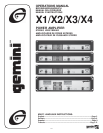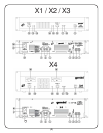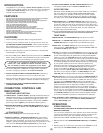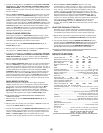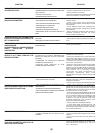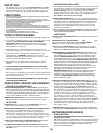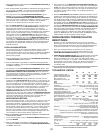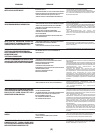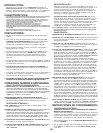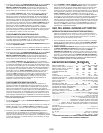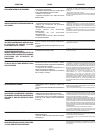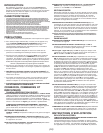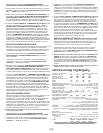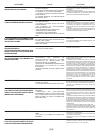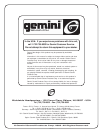(4)
3. Connect the loudspeakers to the Channel 1 and Channel 2 SPEAKER
OUTPUTS (5,7). THE TOTAL SPEAKER LOAD MUST BE AT LEAST 4
OHMS PER CHANNEL. If you try to operate at a lower impedance, the
amplifier will go into protection mode and stop operation until you correct
the load conditions.
4. With the LEVEL CONTROLS (12,15) of both channels set to zero (fully
counterclockwise), turn the POWER SWITCH (9) on. Apply a signal to
the input of the amplifier. The level of the input signal should be as high
as you will ever need it to be. This way, it will be as high above the
amplifier’s noise floor as possible, ensuring an excellent performance
and signal to noise ratio. Adjust the LEVEL CONTROLS (12,15) for each
channel to achieve the desired maximum listening level. Note, when the
CLIP LED (14) light, there is distortion present in the amplifier’s output
section. If a CLIP LED (14) remains on or flashes repeatedly, reduce the
signal level by lowering the input level control for the channel that is
clipping or reduce the level at the source.
PARALLEL MONO OPERATION:
Follow these instructions for Parallel Mono Operation using a single
input cable, and you will have the same monophonic signal on both the
Channel 1 and the Channel 2 outputs. Each channel’s output is
controlled independently by that channel’s level control.
1. With the power off, set the OPERATION MODE SWITCH (3) to the
Parallel Mono position.
2. With the power off, connect your input cables to the Channel 1 input
only using the 1/ 4" INPUT JACK (1) of Channel 1.
3. Connect the loudspeakers to the Channel 1 and Channel 2 SPEAKER
OUTPUTS (5, 7). THE TOTAL SPEAKER LOAD MUST BE AT LEAST 4
OHMS PER CHANNEL. If you try to operate at less than 4 Ohms per
channel, the amplifier will go into the protection mode and stop operation
until you correct the load conditions.
4. With the LEVEL CONTROLS (12,15) set to zero (fully counterclockwise),
switch the POWER (9) on. Apply a signal to the input. The level of the
input signal should be as high as you will ever need it to be. This way, it
will be as high above the amplifier’s noise floor as possible, ensuring an
excellent performance and signal to noise ratio. Adjust the LEVEL
CONTROLS (12,15) for each channel to achieve the desired maximum
listening level. Note, when the CLIP LED (14) light, there is distortion
present in the amplifier’s output section. If a CLIP LED (14) remains on or
flashes repeatedly, reduce the signal level by lowering the input level
control for the channel that is clipping or reduce the level at the source.
MONO BRIDGE OPERATION:
Follow these instructions to bridge the unit’s output. Bridging the
amplifier converts the unit to a monophonic or single channel amplifier .
The amplifier can be used with 8 Ohm or higher loads only in Mono
Bridge mode. This mode is used to provide a higher voltage with
greater headroom to your speaker. Before setting your amplifier for
Mono Bridge operation, make sure that your speaker can handle the
high power level provided by the amplifier in Mono Bridge mode.
CAUTION: VOLTAGE OVER 100 VOLTS MAY BE PRODUCED AT THE BRIDGE OUTPUT
TERMINALS IN THIS MODE.
1. With the power off, set the OPERATION MODE SWITCH (3) to the
BRIDGE position.
2. With the power off, connect your input cables to Channel 1 input only
using the 1/4" INPUT JACK (1) of channel 1.
3. Connect the loudspeaker to the BRIDGE SPEAKER OUTPUT (6) only. Be
sure the polarity of your connection is correct. The total speaker load
must be at least 8 Ohms or above. If you try to operate at less than 8
Ohms in the Mono Bridge mode, the amplifier will go into the
protection mode and stop operation until you correct the load conditions.
4. With the Channel 1 LEVEL CONTROL (15) set to zero (fully
counterclockwise), switch the power on. Apply a signal to the input.
The level of the input signal should be as high as you will ever need it
to be. This way, it will be as high above the amplifier’s noise floor as
possible, ensuring an excellent performance and signal to noise ratio.
Adjust the LEVEL CONTROL (15) for Channel 1 to achieve the desired
maximum listening level. Note, when the CLIP LED (14) light, there is
distortion present in the amplifier’s output section. If a CLIP LED (14)
remains on or flashes repeatedly, reduce the signal level by lowering the
input level control for Channel 1 or reduce the level at the source.
During Mono Bridge operation, the Channel 2 level is inactive,
however, both channels’ LED will flash simultaneously and show output
conditions.
USING THE GROUND LIFT SWITCH:
Depending on your system configuration, sometimes applying the
ground will create a quieter signal path. Sometimes lifting the ground
can eliminate ground loops and hum to create a quieter signal path.
1. With the power amp on, listen to the system in idle mode (no signal present)
with the ground applied (the GROUND LIFT SWITCH (4) in the left position).
2. Turn the power off before moving the GROUND LIFT SWITCH (4). Lift the
ground by moving the GROUND LIFT SWITCH (4) to the right, turn the power
back on and listen to determine which position will provide a signal free of
background noise and hum. Keep the GROUND LIFT SWITCH (4) in the
ground position if the noise level remains the same in either position.
CAUTION: DO NOT TERMINATE THE AC GROUND ON THE POWER AMPLIFIER IN ANY WAY.
TERMINATION OF THE AC GROUND CAN BE HAZARDOUS.
SPECIFICATIONS:
X1 X2 X3 X4
Output Power EIA:.................................................1kHz @ 1% THD, Wrms
Both Channels Driven 8Ω 85 140 200 200
Both Channels Driven 4Ω 110 200 300 300
Mono Bridge 8Ω 220 400 600 600
Dynamic Headroom, dB:
At8Ω 1.4 1.5 1.6 1.6
At4Ω 1.9 2.0 2.2 2.2
Frequency Response..........................................................30 Hz - 50 kHz
Total Harmonic Distortion.............Iess than 0.05%, typical 0.02% @ 1 kHz
Signal to Noise ratio.............................100 dB below rated power @ 8Ω
Damping factor.......................................................greater than 200 @ 8Ω
Slew rate........................................................................................20 V/µS
Voltage gain, dB 28 30 32 32
Input Sensitivity (for rated power at 8Ω).........................................1 Vrms
Input Impedance Unbalanced.............................................................10 kΩ
Input Impedance Balanced.................................................................20 kΩ
Power consumption, W 500 800 1200 1200
(at rated power at 4Ω, both channels driven)
AC Power Requirements..........110-120 V / 60 Hz and 220-240 V / 50 Hz
Indicators:...............................................................................1 Power LED
...............................................................................................1 Protect LED
..................................................1 Signal LED per Channel (for X1, X2, X3)
.................................................................1VU-meter per Channel (for X4)
Cooling........................................................ Fan, Front-to-Rear Forced Air
Protection:.............................................Short Circuit, DC, Thermal Cut-off,
...............................................................Sub/Ultrasonic Frequency Filters,
.......................................Turn-on Delay, Main Fuse, Secondary DC Fuses
Connectors:
Balanced/Unbalanced lnputs........................................................1/4" Jack
Speaker Outputs........................................................5-way Binding Posts
Dimensions:
X1, X2, X3...........................19"W x 10.75"D x 3.5"H (483 x 273 x 89 mm)
X4....................................19"W x 10.75"D x 5.25"H (483 x 273 x 133 mm)
Weight 16.3 Ibs 17.8 Ibs 20.2 Ibs 21.6 Ibs
7.4 kg 8.1 kg 9.2 kg 9.8 kg
SPECIFICATIONS AND DESIGN ARE SUBJECT TO CHANGE WITHOUT NOTICE FOR PURPOSE
OF IMPROVEMENT



